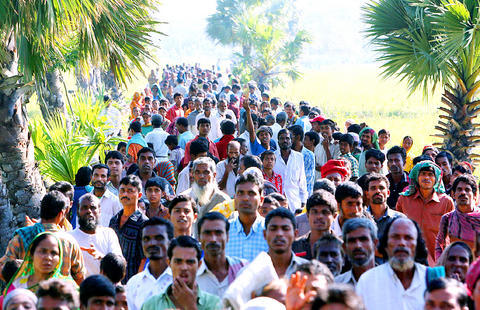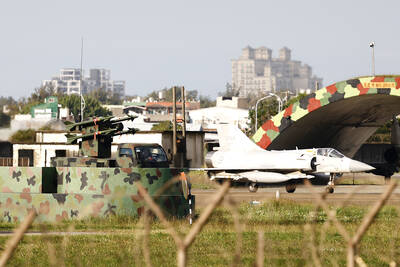Helicopters airlifted food to hungry survivors yesterday while rescuers struggled to reach remote areas devastated by Bangladesh's worst cyclone in a decade, amid fears the toll could be far higher than the official figure of 3,113.
The army helicopters carried mostly high-protein cookies supplied by the World Food Program (WFP), said Emamul Haque, a spokesman for the WFP office in Dhaka, which is coordinating international relief efforts.
International aid organizations promised initial packages of US$25 million during a meeting with Bangladesh agencies yesterday, Haque said.

PHOTO: AFP
The death toll hit 3,113 after reports finally reached Dhaka from storm-ravaged areas which had been largely cut off because of washed-out roads and downed telephone lines, said Lieutenant Colonel Main Ullah Chowdhury, a spokesman of the army coordinating the relief and rescue work.
The Bangladesh Red Crescent Society warned the toll could hit 10,000 once rescuers reach outlying islands, saying the estimate came from volunteers in rescue operations so far.
"The tragedy unfolds as we walk through one after another devastated village," said relief operator Mohammad Selim in Bagerhat, one of the worst-hit areas. "Often it looks like we are in a valley of death."
Grieving survivors had grim tales about losing loved ones.
In Galachipa, a fishing village along the coast in Patuakhali district, Dhalan Mridha and his family ignored the high cyclone alert issued by the authorities through radio and the Red Crescent volunteers.
When Mridha realized his mistake, it was too late.
"Just before midnight the winds came like hundreds of demons. Our small hut was swept away like a piece of paper and we all ran for shelter," said Mridha, a 45-year-old farm worker, weeping.
Mridha was separated from his wife, mother and two children while on his way to the shelter, a two-story building several blocks from his home. The next morning he found their bodies stuck up in a battered bush along the coast.
Mridha said he was too exhausted even to cry for their loved ones.
Local media described much of the coast as a vast valley of death and destruction, and said many grieving families buried their relatives in the same grave because they lacked any adult male survivors to dig graves.
While it will take several days to determine the number of dead and missing, some 3 million survivors who were either evacuated from the low-lying southern coast or whose homes and villages were destroyed will need support, the government said.
Relief items like tents, rice and water have been slow to reach many.
Government officials defended the relief efforts so far, and expressed confidence that authorities are up to the task.
"We have enough food and water," said Shahidul Islam, the top official in Bagerhat, a battered district near the town of Barguna. "We are going to overcome the problem."
Helicopters flew sorties to devastated areas, dropping food, drinking water and medicine for the survivors.
"But there are not many places where we can land," said one pilot, as large areas were still under water.
World Vision, one of many non-governmental groups working to help the cyclone survivors, said yesterday some 1,000 fishermen were still unaccounted for.
"Many of us climbed up on trees in the Sundarban forest, but I fell down in panic when I saw a tiger below," said a fisherman on Dublarchar island. "The waves then swept me further into the mangrove and I found myself alive when the cyclone was over."
The Sundarban forest, home to the endangered Royal Bengal Tiger and a World Heritage site, was badly hit.
Disaster Management Secretary Aiyub Bhuiyan met with representatives from the UN and international aid groups on Sunday to discuss the emergency response.
UN Secretary-General Ban Ki-moon said in a statement that several million dollars are available from the UN's emergency response funds, depending on the need.

Taiwan is gearing up to celebrate the New Year at events across the country, headlined by the annual countdown and Taipei 101 fireworks display at midnight. Many of the events are to be livesteamed online. See below for lineups and links: Taipei Taipei’s New Year’s Party 2026 is to begin at 7pm and run until 1am, with the theme “Sailing to the Future.” South Korean girl group KARA is headlining the concert at Taipei City Hall Plaza, with additional performances by Amber An (安心亞), Nick Chou (周湯豪), hip-hop trio Nine One One (玖壹壹), Bii (畢書盡), girl group Genblue (幻藍小熊) and more. The festivities are to

Auckland rang in 2026 with a downtown fireworks display launched from New Zealand’s tallest structure, Sky Tower, making it the first major city to greet the new year at a celebration dampened by rain, while crowds in Taipei braved the elements to watch Taipei 101’s display. South Pacific countries are the first to bid farewell to 2025. Clocks struck midnight in Auckland, with a population of 1.7 million, 18 hours before the famous ball was to drop in New York’s Times Square. The five-minute display involved 3,500 fireworks launched from the 240m Sky Tower. Smaller community events were canceled across New Zealand’s

‘IRRESPONSIBLE’: Beijing’s constant disruption of the ‘status quo’ in the Taiwan Strait has damaged peace, stability and security in the Indo-Pacific region, MOFA said The Presidential Office yesterday condemned China’s launch of another military drill around Taiwan, saying such actions are a “unilateral provocation” that destabilizes regional peace and stability. China should immediately stop the irresponsible and provocative actions, Presidential Office spokeswoman Karen Kuo (郭雅慧) said, after the Chinese People’s Liberation Army (PLA) yesterday announced the start of a new round of joint exercises around Taiwan by the army, navy and air force, which it said were approaching “from different directions.” Code-named “Justice Mission 2025,” the exercises would be conducted in the Taiwan Strait and in areas north, southwest, southeast and east of Taiwan

UNDER WAY: The contract for advanced sensor systems would be fulfilled in Florida, and is expected to be completed by June 2031, the Pentagon said Lockheed Martin has been given a contract involving foreign military sales to Taiwan to meet what Washington calls “an urgent operational need” of Taiwan’s air force, the Pentagon said on Wednesday. The contract has a ceiling value of US$328.5 million, with US$157.3 million in foreign military sales funds obligated at the time of award, the Pentagon said in a statement. “This contract provides for the procurement and delivery of 55 Infrared Search and Track Legion Enhanced Sensor Pods, processors, pod containers and processor containers required to meet the urgent operational need of the Taiwan air force,” it said. The contract’s work would be